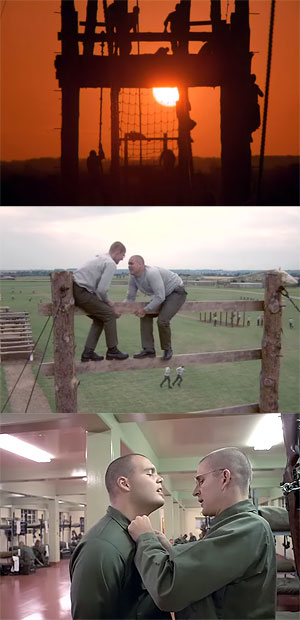
Full Metal Jacket
Warner Bros.
Original release: June 26th, 1987
Running time: 116 minutes
Director: Stanley Kubrick
Writers: Stanley Kubrick, Michael Herr, Gustav Hasford
Cast: Matthew Modine, Adam Baldwin, Vincent D’Onofrio, R. Lee Ermey
Locked and loaded 00:40:50 to 00:45:30
Deconstructing Cinema: One Scene At A Time, the complete series so far

I’ve often wondered if I’d be able to cope with army life. I don’t know why I tend to think about it every so often; signing up is not something I’ve ever had to seriously consider. During my lifetime so far we’ve not faced the kind of conflicts like Vietnam and World War I and II that saw men as young as 17 being drafted for service, but it weighs on my mind – not just the fighting on the field, but what goes on in training. Would I even make it that far? How long would it take for me to buckle and break under such conditions?
It’s like a nightmare when I think about it and Stanley Kubrick’s Full Metal Jacket doesn’t make it any less awful. Released in 1987, during the few years when we also saw Platoon (1986), Casualties Of War (1989) and Born On The Fourth of July (1989) released, it’s an intense and sometimes darkly funny film which begins at the US Marine boot camp at Parris Island where we see the new recruits having their heads shaved and then meeting their Senior Drill Instructor, Gunnery Sergeant Hartman (R. Lee Ermey). This is a man who makes my high school P.E. teacher look like Mickey Mouse as he employs the toughest tactics to mould these boys into killing machines.
Among them is the overweight misfit Marine Private “Pyle” Leonard Lawrence (Vincent D’Onofrio). The actor, who gained a record breaking 70 lb (32 kg), adding to a total weight of 280 lb (130 kg), is painfully compelling to watch. Within the film’s first few minutes Hartman’s set his sights on him and delivers his motivational speech in no uncertain terms in attempt to break him. It’s also the scene where Hartman changes Lawrence’s name to Gomer Pyle, after the naïve and bumbling television character played by Jim Nabors on The Andy Griffith Show.

I don’t like the name Lawrence! Only faggots and sailors are called Lawrence! From now on you’re Gomer Pyle!
PYLE:
Sir, yes, sir!
Once Lawrence takes on the name Gomer Pyle his life at Parris Island doesn’t get any easier. We see him succumbing to an even further tirade of physical and mental abuse at Hartman’s hands, which tell us more about the sergeant’s unstable state of mind than they do about Pyle’s. As Private Joker (Matthew Modine) starts to take him under his wing he teaches Pyle how to handle his rifle, lace his shoes, make his bed and helps him overcome some of the obstacles in his training. Through this we see a friendship developing between the two men and Pyle finally makes some. That’s until a jelly doughnut is discovered in his footlocker and Hartman responds to this by starting to punish the entire group for Pyle’s mistakes, without actually punishing Pyle.
The group, unhappy about these turn of events, decide to haze him with a blanket party. They restrain him in his bed with a blanket and beat him bars of soap tied to towels. Even Joker is forced to take part and after beating his friend the hardest he covers his ears in the bunk below, unable to listen to him crying. As a result of the hazing, Pyle seems to become a model Marine and while he manages to impress the sadistic Drill Sergeant, Joker’s concern grows when he recognises signs of a mental breakdown. We hear Hartman telling the group that Charles Whitman, who killed 12 people at up to 400 yards, and Lee Harvey Oswald, who shot the president twice, learnt to shoot in the Marines. ¹
With Pyle now talking to his M14 rifle we know it won’t be long until he uses it. After what he’s been through we wonder what we would do in his situation. Would we have coped as long he has? After their graduation and on the platoon’s final night on Parris Island Joker stumbles upon Pyle in the bathroom where he’s sitting with his rifle, loading it with ammunition. After Joker tries and fails at diffusing the situation Pyle starts to bark out drill commands and recites the Rifleman’s Creed which wakes everyone up and brings Hartman over to see what the commotion’s all about.
This is my rifle. There are many like it, but this one is mine. My rifle is my best friend.

Pyle ignores Hartman’s order to surrender his rifle and instead fires it into his chest at close range – falling backwards is blood splattering slow motion. Backing up, Pyle then falls back onto one of the toilets and puts the weapon into his mouth and pulls the trigger, blowing a large hole through his head. It’s a moment we all knew was coming, but it doesn’t lessen the impact of seeing his brains splattered across the tiled walls. The scene then fades to black.
Following Paths Of Glory (1957) and Dr. Strangelove (1964), Full Metal Jacket delivers us the third instalment in Kubrick’s anti-war trilogy with its jarring mix of battle and satire while at the same time showing us what the filmmaker things of the Marine Corps.
“The first forty minutes of the film depict yet another conditioning process, Marine Corps boot camp, which in this case is designed to rob the men of their individuality and mold them into a fighting unit. The necessity of this type of training is explained and celebrated in such John Wayne vehicles as Sands of Iwo Jima (1949), but here, the production of thoughtless killing machines is condemned.” ²
Though Abrams points to the Marine Corps boot camp as being designed to rob the men of their individuality, Marita Sturken notes that what Hartman’s trying to do is excise the feminine out of him.
“Here the feminine is represented in the figure of Private Leonard Lawrence, dubbed “Gomer Pyle” by the abusive drill sergeant. Pyle, who is feminized by both his real name (“Lawrence what, of Arabia?” mocks the sergeant) and his nickname, is a fat boy who is hopelessly unsuited for boot camp, cannot stop smiling at the abuse, has a crush on Private Joker, and hides doughnuts in his footlocker. When Sergeant Hartman punishes the entire group of recruits for Pyle’s mistakes, they turn on Pyle in rage, beating him at night, hating him for what he represents about themselves.” ³
- [1] Duncan, P. Stanley Kubrick (2005), Taschen GmbH
- [2] Abrams, J.J. The Philosophy of Stanley Kubrick (2007), The University Press of Kentucky
- [3] Sturken, M. Tangled Memories: The Vietnam War, the AIDS Epidemic, and the Politics of Remembering (1997), University of California Press
While it’s an interesting angle to explore, it’s not one I agree with and I stand by Abrams on it being more about robbing the men of their individuality as emotions and latent feelings of desire are not exclusive to the female sex, nor should they be deemed as “feminine”, but something which identifies us as species, not as a sex. Yet however we choose to look at Full Metal Jacket; either in its first half, later half or in its entirety, we can’t deny that at its core it’s a film which brings us face to face with war and what we’re expected to sacrifice for it by men like Hartman.
Although Pyle’s suicide takes place halfway through the film, his treatment and breakdown remains with us as we continue to watch. It’s the result of what Hartman’s put him through, and like Whitman and Oswald, Pyle too has learned how to shoot in the Marines. The Drill Sergeant would be proud if he wasn’t dead.

Patrick Samuel
The founder of Static Mass Emporium and one of its Editors in Chief is an emerging artist with a philosophy degree, working primarily with pastels and graphite pencils, but he also enjoys experimenting with water colours, acrylics, glass and oil paints.
Being on the autistic spectrum with Asperger’s Syndrome, he is stimulated by bold, contrasting colours, intricate details, multiple textures, and varying shades of light and dark. Patrick's work extends to sound and video, and when not drawing or painting, he can be found working on projects he shares online with his followers.
Patrick returned to drawing and painting after a prolonged break in December 2016 as part of his daily art therapy, and is now making the transition to being a full-time artist. As a spokesperson for autism awareness, he also gives talks and presentations on the benefits of creative therapy.
Static Mass is where he lives his passion for film and writing about it. A fan of film classics, documentaries and science fiction, Patrick prefers films with an impeccable way of storytelling that reflect on the human condition.
© 2022 STATIC MASS EMPORIUM . All Rights Reserved. Powered by METATEMPUS | creative.timeless.personal. | DISCLAIMER, TERMS & CONDITIONS
HOME | ABOUT | CONTACT | TWITTER | GOOGLE+ | FACEBOOK | TUMBLR | YOUTUBE | RSS FEED
CINEMA REVIEWS | BLU-RAY & DVD | THE EMPORIUM | DOCUMENTARIES | WORLD CINEMA | CULT MOVIES | INDIAN CINEMA | EARLY CINEMA
MOVIE CLASSICS | DECONSTRUCTING CINEMA | SOUNDTRACKS | INTERVIEWS | THE DIRECTOR’S CHAIR | JAPANESE CINEMA





